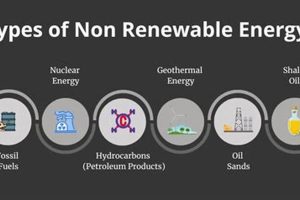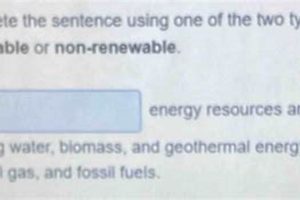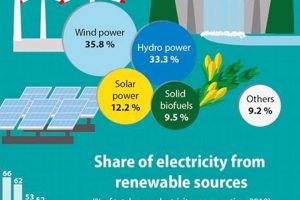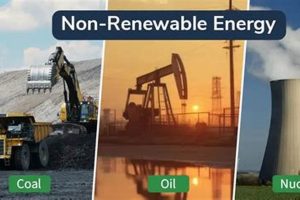Non-renewable energy resources originate from geological processes that take millions of years to form. These finite resources include fossil fuels (coal, oil, and natural gas) and nuclear fuels (uranium). Fossil fuels are formed from the remains of ancient plants and animals subjected to immense heat and pressure over vast spans of time. Nuclear fuels are derived from uranium ore, a naturally occurring radioactive element found in the Earth’s crust.
These energy sources have played a crucial role in powering industrialization and modern society. Their high energy density and relative ease of extraction and utilization have driven economic growth and technological advancements. However, their finite nature and environmental impact necessitate a transition to more sustainable energy alternatives.
A deeper exploration of individual non-renewable resources will illuminate their distinct characteristics, extraction processes, and environmental consequences. Further analysis will also address the challenges and opportunities associated with transitioning away from these resources and toward a more sustainable energy future.
Tips for Understanding Non-Renewable Energy Sources
Informed decision-making regarding energy consumption requires a clear understanding of the characteristics and implications of using non-renewable resources. The following tips offer guidance for navigating this complex topic.
Tip 1: Recognize the Finite Nature: Non-renewable resources are finite. Their extraction and consumption deplete a limited supply, necessitating long-term planning for alternative energy sources.
Tip 2: Understand Environmental Impacts: The combustion of fossil fuels releases greenhouse gases, contributing to climate change. Extraction processes can also disrupt ecosystems and pollute surrounding environments.
Tip 3: Consider Energy Security: Reliance on non-renewable resources can create vulnerabilities to price volatility and geopolitical instability. Diversifying energy sources enhances energy security.
Tip 4: Explore Energy Efficiency: Reducing energy consumption through efficiency measures minimizes the demand for non-renewable resources and mitigates their environmental impact.
Tip 5: Support Renewable Energy Development: Transitioning to renewable energy sources offers a sustainable path towards reducing reliance on finite resources and mitigating climate change.
Tip 6: Research and Stay Informed: The energy landscape is constantly evolving. Staying informed about the latest developments in energy technology and policy is crucial for making informed choices.
Tip 7: Advocate for Sustainable Practices: Supporting policies and initiatives that promote sustainable energy practices contributes to a more secure and environmentally responsible energy future.
By understanding the limitations and implications associated with non-renewable energy, individuals and communities can make informed decisions that promote a sustainable energy future.
This understanding provides a foundation for further exploration of specific non-renewable resources and the ongoing transition towards sustainable alternatives.
1. Fossil Fuels
Fossil fuels represent a dominant category within non-renewable energy sources. Their formation over geological timescales from organic matter results in energy-rich substances that have powered industrial society for centuries. Understanding their composition, extraction, and utilization is crucial for comprehending the complexities of non-renewable energy.
- Formation and Composition
Fossil fuels originate from the decomposition of ancient plant and animal matter subjected to intense heat and pressure over millions of years. Coal is formed primarily from plant remains, while oil and natural gas derive from marine organisms. Their chemical composition consists primarily of hydrocarbons, which store significant amounts of energy released through combustion.
- Extraction Methods
Extraction methods vary depending on the type of fossil fuel. Coal is extracted through mining, both surface and underground. Oil and natural gas are extracted through drilling, often involving complex infrastructure and technologies to access deep reserves. These extraction processes can have significant environmental impacts, including habitat disruption, land degradation, and water pollution.
- Utilization and Energy Production
Fossil fuels are primarily utilized through combustion, a chemical process that releases heat energy. This heat energy can be used directly for heating purposes or converted into other forms of energy, such as electricity through power plants. The widespread use of fossil fuels in transportation, industry, and electricity generation underscores their importance in the current energy landscape.
- Environmental Implications
The combustion of fossil fuels releases greenhouse gases, primarily carbon dioxide, contributing to climate change. Extraction processes can also lead to habitat destruction, water contamination, and air pollution. These environmental consequences necessitate a transition to cleaner and more sustainable energy sources.
The reliance on fossil fuels as a primary energy source poses significant challenges due to their finite nature and environmental impact. Understanding these aspects is essential for evaluating the long-term sustainability of current energy systems and for promoting the development and adoption of renewable alternatives.
2. Nuclear Fuels
Nuclear fuels constitute a distinct category within non-renewable energy sources, offering a high energy density alternative to fossil fuels. Unlike fossil fuels derived from organic matter, nuclear fuels originate from radioactive elements, primarily uranium, found within the Earth’s crust. This distinction underscores a fundamental difference in their formation and utilization within the broader context of non-renewable energy.
Uranium, the primary nuclear fuel, undergoes nuclear fission in reactors. This process releases significant amounts of energy utilized for electricity generation. While nuclear power plants don’t emit greenhouse gases during operation, the nuclear fuel cycle presents other challenges. Uranium mining and processing generate radioactive waste, requiring careful management and long-term storage solutions. The risk of nuclear accidents, such as Chernobyl and Fukushima, further complicates the utilization of nuclear fuels as a non-renewable energy source. For example, the Fukushima Daiichi nuclear disaster in 2011, triggered by a tsunami, resulted in widespread environmental contamination and raised serious concerns about the safety of nuclear power. This event exemplifies the potential consequences associated with nuclear energy, highlighting the necessity of robust safety protocols and comprehensive waste management strategies.
Nuclear fuels offer a significant energy resource, but their utilization requires careful consideration of the entire fuel cycle, from uranium mining to waste disposal. The environmental impact of radioactive waste and the potential for accidents necessitate ongoing research and development of safer and more sustainable nuclear technologies. Understanding these complexities is essential for evaluating the role of nuclear fuels within the larger framework of non-renewable energy sources and for charting a responsible course toward a sustainable energy future.
3. Finite Resources
The finite nature of non-renewable energy resources forms a central challenge in their utilization. Because these resources are not replenished at a rate comparable to human consumption, their reserves are ultimately limited. Understanding this finite nature is crucial for evaluating long-term energy strategies and for promoting the transition to renewable alternatives. This section explores key facets of resource finiteness within the context of non-renewable energy.
- Resource Depletion
Continuous extraction and consumption of non-renewable resources inevitably lead to depletion. As reserves diminish, extraction becomes more challenging and costly, potentially leading to price volatility and supply disruptions. For example, conventional oil reserves are becoming increasingly difficult to access, requiring more complex and expensive extraction technologies.
- Geological Timescales
Non-renewable resources form over geological timescales, typically millions of years. This slow formation process stands in stark contrast to the rate of human consumption, highlighting the imbalance between resource replenishment and depletion. The vast timescales involved underscore the finite nature of these resources within human timeframes.
- Economic Implications
The finite nature of non-renewable resources has significant economic implications. Depletion can lead to price fluctuations, impacting industries and consumers reliant on these resources. Furthermore, geopolitical tensions can arise over access to dwindling reserves, affecting international relations and energy security. For instance, competition for remaining oil reserves can exacerbate existing political conflicts.
- Sustainability Challenges
The finite nature of non-renewable resources presents a fundamental sustainability challenge. Reliance on these resources is inherently unsustainable in the long term, necessitating a transition to renewable energy sources. This transition requires significant investments in research, development, and infrastructure to ensure a secure and sustainable energy future.
The finite nature of non-renewable energy resources necessitates a shift in energy strategies. Understanding the implications of resource depletion, geological timescales, economic factors, and sustainability challenges is crucial for informed decision-making and for promoting the transition towards a more sustainable energy future reliant on renewable resources.
4. Geological Formation
Geological formation plays a crucial role in the existence of non-renewable energy sources. These resources, primarily fossil fuels (coal, oil, and natural gas) and uranium ore, are products of specific geological processes occurring over vast spans of time. Understanding these processes is fundamental to comprehending the origin, distribution, and finite nature of these energy sources.
Fossil fuels form from the remains of ancient organisms subjected to specific conditions over millions of years. Coal originates from plant matter buried in anaerobic environments, undergoing gradual transformation through pressure and heat. Oil and natural gas form from marine organisms buried under layers of sediment, experiencing similar transformations under high temperature and pressure conditions. The geological conditions required for these transformations occur in specific sedimentary basins, influencing the global distribution of these resources. For instance, the Middle East, rich in oil reserves, boasts geological formations conducive to oil formation and accumulation. Similarly, regions abundant in coal often exhibit geological histories of extensive swamp forests subsequently buried and transformed.
Uranium, the primary fuel for nuclear energy, is a naturally occurring radioactive element found within specific rock formations. Its concentration in economically viable deposits is a result of geological processes like hydrothermal activity and weathering. The geological context of uranium deposits dictates the methods employed for extraction, influencing the economic feasibility and environmental impact of uranium mining. Recognizing these geological factors offers insights into the challenges associated with uranium resource availability and its lifecycle.
Understanding the geological formation of non-renewable energy sources provides a crucial framework for resource management, exploration, and the development of extraction technologies. This knowledge also underscores the finite nature of these resources, highlighting the need for a transition to sustainable energy alternatives. The geological processes shaping the formation and distribution of non-renewable energy dictate their availability and accessibility, ultimately influencing global energy dynamics and future sustainability strategies.
5. Extraction Processes
Extraction processes represent a critical link between non-renewable energy sources and their utilization. These processes encompass the methods employed to access and retrieve resources such as fossil fuels (coal, oil, and natural gas) and uranium ore from the Earth. The nature of these processes varies significantly depending on the specific resource, its geological location, and technological advancements. Understanding these extraction methods is essential for evaluating the economic feasibility, environmental impact, and overall sustainability of non-renewable energy utilization.
- Mining (Coal and Uranium)
Mining serves as the primary extraction method for solid non-renewable resources like coal and uranium. Coal mining involves various techniques, including surface mining (strip mining, open-pit mining) and underground mining (longwall mining, room and pillar mining). Uranium mining employs similar methods, adapted to the specific geological occurrences of uranium ore. Mining operations can significantly alter landscapes, disrupt ecosystems, and generate substantial waste materials, raising environmental concerns regarding land reclamation, water pollution, and air quality.
- Drilling (Oil and Natural Gas)
Oil and natural gas, typically found in underground reservoirs, are extracted through drilling. This process involves boring deep wells into the Earth’s crust, often utilizing advanced drilling technologies to access challenging geological formations. Offshore drilling extends this process to marine environments, posing unique challenges and environmental risks associated with potential spills and ecosystem disruption. Drilling operations can also contribute to land subsidence and groundwater contamination, requiring careful management and mitigation strategies.
- Processing and Refining
Extracted resources often require processing and refining before utilization. Crude oil undergoes refining to separate various components, such as gasoline, diesel, and kerosene. Natural gas may require processing to remove impurities. Uranium ore undergoes milling and chemical processing to extract uranium oxide (yellowcake), a crucial step in nuclear fuel production. These processes can generate hazardous waste materials, requiring careful handling and disposal to minimize environmental impacts.
- Technological Advancements
Technological advancements continually reshape extraction processes, improving efficiency and addressing environmental challenges. Hydraulic fracturing (fracking) has revolutionized natural gas extraction, enabling access to previously unreachable reserves. Enhanced oil recovery techniques maximize extraction from existing oil fields. These technological developments influence resource accessibility and economic viability, while also raising new environmental considerations related to water usage, chemical contamination, and induced seismicity.
Extraction processes form an integral part of the non-renewable energy lifecycle. Understanding the diverse methods employed, their environmental impacts, and the influence of technological advancements provides critical insights into the complexities of non-renewable energy utilization. These considerations are essential for evaluating the long-term sustainability of these resources and for guiding the transition towards more sustainable energy alternatives.
6. Environmental Impact
Non-renewable energy sources exert significant environmental impacts throughout their lifecycle, from extraction to utilization. Understanding these impacts is crucial for evaluating the sustainability of these energy sources and for informing the transition to more environmentally responsible alternatives. The following facets explore the key environmental consequences associated with non-renewable energy.
- Greenhouse Gas Emissions
Combustion of fossil fuels releases substantial amounts of greenhouse gases, primarily carbon dioxide, into the atmosphere. These gases contribute to climate change, a phenomenon with far-reaching consequences, including rising global temperatures, altered weather patterns, and sea-level rise. The magnitude of these emissions underscores the urgent need for mitigating their impact through transitioning to cleaner energy sources and implementing carbon capture technologies. For example, the continued reliance on coal-fired power plants contributes significantly to global CO2 emissions.
- Air and Water Pollution
Extraction and processing of non-renewable resources can lead to significant air and water pollution. Mining operations can release dust and heavy metals into the air, while wastewater discharge can contaminate water sources with toxic chemicals. Oil spills, a major risk associated with oil extraction and transportation, can devastate marine ecosystems and coastal communities. These pollution events pose serious threats to human health and ecological integrity. For instance, acid mine drainage from coal mines can contaminate rivers and streams, harming aquatic life.
- Land Degradation and Habitat Loss
Extraction activities, particularly mining and drilling, can cause significant land degradation and habitat loss. Surface mining operations remove vegetation and topsoil, disrupting ecosystems and impacting biodiversity. Drilling activities can fragment habitats and disturb wildlife. These land-use changes can have long-term consequences for ecological stability and ecosystem services. For example, mountaintop removal mining for coal drastically alters landscapes and destroys habitats.
- Waste Management
Non-renewable energy sources generate various waste products requiring careful management. Nuclear power plants produce radioactive waste that necessitates long-term storage solutions. Fossil fuel combustion generates ash and other byproducts that can contaminate soil and water. Proper waste disposal and management are essential for minimizing environmental risks. For example, the safe disposal of spent nuclear fuel remains a significant challenge.
The environmental impacts associated with non-renewable energy sources present significant challenges to sustainability. Addressing these challenges requires a multifaceted approach that includes transitioning to renewable energy sources, implementing stricter environmental regulations, developing cleaner technologies, and promoting responsible resource management. Understanding these environmental consequences is paramount for shaping a sustainable energy future that minimizes ecological damage and safeguards human well-being.
Frequently Asked Questions about Non-Renewable Energy Sources
Addressing common inquiries regarding non-renewable energy sources provides clarity and fosters informed perspectives on their role in the global energy landscape. The following questions and answers offer insights into key aspects of these resources.
Question 1: Why are these resources termed “non-renewable”?
These resources are classified as “non-renewable” due to the vast timescales required for their formation. The rate of consumption significantly surpasses the rate of natural replenishment, effectively rendering them finite within human timescales.
Question 2: What are the primary environmental concerns associated with their use?
Primary environmental concerns include greenhouse gas emissions contributing to climate change, air and water pollution stemming from extraction and combustion processes, land degradation resulting from mining and drilling activities, and the challenges of waste management, especially regarding nuclear waste.
Question 3: How does the finite nature of these resources impact long-term energy planning?
The finite nature necessitates strategic planning for a transition to renewable energy sources. Depletion of these resources poses economic and geopolitical risks, highlighting the importance of diversifying energy portfolios and investing in sustainable alternatives.
Question 4: What role do technological advancements play in the utilization of these resources?
Technological advancements influence extraction efficiency, resource accessibility, and environmental impact. Innovations like hydraulic fracturing and enhanced oil recovery techniques have expanded access to resources, but also raise new environmental considerations.
Question 5: How does the global distribution of these resources influence geopolitical dynamics?
Uneven distribution of these resources creates interdependencies and potential vulnerabilities among nations. Access to and control over these resources can influence international relations, trade agreements, and geopolitical strategies.
Question 6: What are the key challenges in transitioning away from these resources?
Key challenges include developing cost-effective renewable energy technologies, establishing reliable energy storage solutions, adapting existing infrastructure, and managing the economic and social implications of transitioning away from a fossil fuel-based economy.
Understanding the complexities of non-renewable energy sources, including their finite nature, environmental impacts, and geopolitical implications, is crucial for navigating the global energy landscape and shaping a sustainable energy future.
Further exploration of specific non-renewable resources and their respective characteristics offers a deeper understanding of their individual roles within the broader energy context. This foundational understanding facilitates informed decision-making and supports the transition towards a more sustainable and secure energy future.
Conclusion
Non-renewable energy sources, encompassing fossil fuels (coal, oil, and natural gas) and nuclear fuels (primarily uranium), represent a finite resource base formed through geological processes over vast timescales. Their extraction and utilization have fueled industrialization and societal development, yet their inherent limitations and environmental consequences necessitate a transition to more sustainable alternatives. The combustion of fossil fuels releases greenhouse gases, contributing to climate change, while nuclear fuels present challenges associated with radioactive waste management and the risk of accidents. Extraction processes, including mining and drilling, can disrupt ecosystems, pollute environments, and degrade landscapes. The finite nature of these resources underscores the need for responsible resource management, energy efficiency measures, and a strategic shift toward renewable energy technologies.
The future of energy relies on a global commitment to sustainable practices. Continued reliance on non-renewable sources presents significant environmental risks and long-term sustainability challenges. Transitioning to a diverse energy portfolio that prioritizes renewable energy sources, coupled with advancements in energy storage and efficiency technologies, is essential for mitigating climate change, ensuring energy security, and building a sustainable energy future for generations to come. Informed decision-making, driven by an understanding of the complexities and limitations of non-renewable energy sources, is crucial for charting a responsible and sustainable energy path forward.







